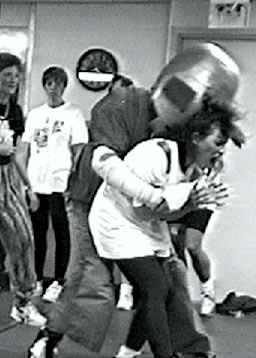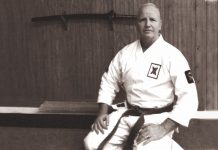Picture this: While strolling back from your favorite pub, a knife-wielding thug demands your dough, then slashes.
Or this: You – a woman – are asleep when a convicted rapist jumps on you and duct tapes your mouth, intent on pounding your face.
When reality bites, you want to be ready…
 Welcome to Padded Assailant Training. Not real thugs, these “attackers” are specially trained mock assailants outfitted in 50 pounds of protective gear allowing for full force strikes to the head, neck, groin and torso. In just a few days of training students’ skills are becoming instinctive, cooking into their muscle memory.
Welcome to Padded Assailant Training. Not real thugs, these “attackers” are specially trained mock assailants outfitted in 50 pounds of protective gear allowing for full force strikes to the head, neck, groin and torso. In just a few days of training students’ skills are becoming instinctive, cooking into their muscle memory.
Once considered a novelty, scenario-based padded assailant training is rapidly becoming the wave of the future filling a much needed gap in martial arts curriculum. From dojos to law enforcement, trainers are strapping on armor looking toward this adrenal-stress model as the magic pill of self defense. Magic it is: When utilized effectively this state-dependent learning imprints combat ready skills into one’s neural-network, and can transform even mild mannered men and women into dangerous, tough minded fighters.
The concept is simple: By training under the pressure of a “real” attack one becomes accustomed to the rush of emotions and physical symptoms brought on via adrenaline dumps – rapid heart rate, shakes, sweats, dry mouth – and is subsequently better prepared; in the event of an actual attack the body registers “been there, done that” and can call up these newly patterned skills without freezing, panicking or succumbing to shock. Without adrenal-stress conditioning even competent martial artists may find themselves flailing, losing motor control or missing targets unable, in this emotionally charged state, to access their normally excellent techniques.
Perhaps most significantly adrenal-stress training develops the internal preparedness – the presence of mind and readiness of heart – that enables one to enter, engage, make lightning fast decisions and ultimately survive. But all such programs are not created equal. Every model of training boasts “realism” and “effectiveness.” But are they? Instead of preparing students for an actual attack, ironically, many students are suffering at the hands of realistic training. Inadequate armor, poor instruction, unrealistic simulations, and the failure to understand both the complexities of the craft and the intense nature of this training can just as easily train students out of effective skills leaving them less prepared to survive a real world confrontation. You don’t just – voila! – don some armor and simulate a “go off.”
To sustain an effective adrenaline-state program you must have clearly delineated goals and incorporate these four elements: (1) Good “muggercraft” to get maximum technique and fighting spirit out of students; (2) Instructor teamwork (this is not a one man job); (3) A graduated step-by-step infrastructure and; (4) A skillful teaching environment that provides the know-how to manage fear and harness the power of emotions.
What follows is a closer look at the essential components for running a program that will help, not hurt your students, and give you a winning edge.
Muggercraft: Doing The Dirty Deed
The responsibility of triggering a genuine stress reaction, then patterning in the correct response rests largely with padded assailant, the bad guy, the “mugger.” Unlike sparring, a mutual contest, the concept here is asymmetric training – a term first coined by Mark Morris, a pioneer in these methods and designer of the armor featured here. Rather than testing or trying to defeat the fighter, your goal is to train the student to react effectively. Your actions in the role of bad guy should be student centered and reflect: “What is this student’s next step? What do I need to draw out of, strengthen or challenge with this student / group?”
Essential to this task is a convincing portrayal of threat and danger. This requires characterization, complete with motive – the scenario. Your goal is to prepare students for circumstances they are most likely to face, so make your characters relevant using the set ups, body language and words they will likely encounter – is he a sadistic bully or a date rapist? Include intimidation gestures, posturing, verbal testing, physical probes and ploys that typically precede assaults and that reflect the M.O. of your character. (Remember though, personifying the dark side requires the utmost integrity; hidden agendas such as personal venting or showing off is a violation of trust and a breach of honor.) Vary your tone and demeanor: act slimy, cruel, nervous, crazy, big and loud, adjusting to fit the character. The key is keeping the atmosphere charged with a visceral sense of threat.
Building intensity is gradual. Our “muggers” start out slow, presenting clear targets and simple set ups enabling students to first develop power, targeting and focus while becoming accustomed to “being attacked”. As skills and confidence increase, attacks become more dynamic adding higher levels of threat and perceived danger. By the training’s end students are attacked unpredictably in full speed simulations.
Because how you train is how you fight, you want your students to counterattack without reservation, striking and throwing full speed, full power. (Of course this calls for armor that can withstand a sustained pounding, without which serious injuries may result or students may be forced to hold back.) To get maximum juice out of your students, the “mugger” should always be in a dynamic flow – either attacking or reacting to blows. “Posing” eliminates the sense of urgency, resulting in the student’s loss of attacking spirit and a false sense of confidence.
Your reaction to the counterattack is the reward… or consequence. Missed openings, flailing, weak and inaccurate blows are ignored or brushed off and the attack continues. Conversely, well timed, sufficiently powerful and on-target hits get dramatic reactions, tactile and visual rewards letting the student know “it’s working.” Gauging the power, respond as an unprotected body would (include grunting, swearing, clutching of body parts and injured expressions – You broke my f…ing nose! I’ll…) but with some adjustment to emphasize the lesson or draw out additional technique. For example, after a good head shot the “mugger’s” body stretches back into an exaggerated arch, creating time and space for the student to charge in and continue his attack. Similarly, while most men are likely to collapse in a column after a solidly connecting groin strike, the “mugger” might drop back two paces to his knees, feeding the hungry fighter another juicy target, drawing out a finishing knee to the head. As students’ skills increase, set-ups and openings become less distinct; jamming, dodging and challenges intensify as fights become increasingly realistic and brutal.
After a blow or succession of blows that you judge would have rendered you unconscious or unable to continue, give a clear signal that the fight is over. We call this “bugging out” – lying on your back with hands fisted over the eyes. Occasionally a single strike or throw warrants “bugging out” but more typically you must incrementally wear down.
It Takes A Team
Not a one man job, the ideal breakdown of a team should include the following players: one or more padded attackers who enact the simulations, offer constructive feedback and when not “mugging” help instruct the class (it is unhealthy and ill advised to only enact the embodiment of evil); and a head instructor who teaches and corrects techniques, then coaches students in the drills and scenarios. Short crisp phrases – Strike!…Move in!…Get Ready!…Elbow!… Kick! – work best. The instructor / coach also calls the end of the fight, best accomplished with a clear signal such as a whistle, and must be prepared to physically intervene should a scenario get out of control or become dangerous to student or attacker – i.e. an after the whistle “cheap shot”.
Coaching remains controversial, the criticism being “but in a real attack, you’re on your own.” True. But remember, the whole purpose of adrenaline-state training is to pattern effective skills into one’s muscle memory. Without a skilled coach – especially at the beginning and during increasingly stepped-up junctures – fighters often flail, waste opportunities and lose focus and control. After an unsuccessful fight, a teamwork model enables you to isolate and remedy a problem then replay a scenario allowing the more effective version to cook-in.
Having a clear division of labor serves many purposes. Keeping the bad guy role separate from that of supportive coach helps the “mugger” maintain a distance and sustain the edge of scariness in scenarios. This is particularly important if you intend to personalize characters based on your students’ fears or histories. In women’s programs, given the intimate nature of simulated sexual assaults, the distinction between “mugger” and coach also provides psychological safety. It reduces the chances that students will become confused by the lack of clear good guy/ bad guy boundaries, or transfer romantic feelings onto the padded attacker. “Being the attacker can be very emotionally difficult, especially when I see terror in a students eyes,” notes Tony Turner, an enthusiastic veteran of scenario-based methods. “Knowing that the coach is helping the student pull up her fighting spirit allows me to stay in predator mode and not tone it down.” By simultaneously working both angles – one challenges; one supports – the student can more quickly rise to the occasion.
On the other hand, if your goal is to integrate this method into ongoing martial arts classes with experienced fighters or to offer a specialized training piece for SWAT teams, it may be appropriate to relax these protocols. The answer lies in who you’re training and for what purpose.
Drills: The Building Blocks of Success
Turning the fearful into the ferocious is a daunting task. The key to success lies in breaking down learning into manageable pieces, then implementing drills to practice each piece.
Drills should be task specific; be clear about the goals you are trying to achieve. For example, the goal of a “woofing” drill is to help students prepare for the ensuing verbal attack and rush of adrenaline. While attackers “woof” or bark at students, pointing then moving closer displaying hostile intent, students learn to settle and use neutral body language while strategically positioning themselves for battle, getting ready on the inside. In later “woofing” drills, students add verbal de-escalating and boundary setting methods.
Because drills don’t need story lines and can cut right to a piece of action, they are excellent tools for honing techniques with the “mugger” but without all the emotional charge of full blown scenarios. For example, in drills focusing on timing and entering techniques, students may start out with their eyes closed before a sound or contact signals the attack. In rape specific modules, women practice reversal drills focusing on “heave off” and kicking techniques emphasizing range and power before adding speed. In another rape defense drill, women have to hunt for or create opportunities to get back on their feet.
Additional drills might focus on rear attacks, releases, pins, throws and finishing techniques or “portal of safety” exercises where the goal is simply to get past the “mugger” to a pre-designated spot symbolizing safety.
All armor presents limitations: our brain-saving helmet makes choke-outs impossible and knee kicking drills, even when safely set up, can become dangerous. Rather than eliminate techniques, cheating students out of essential survival tools, augment your training with other practical methods. Even without armor, you can capitalize on adrenaline-state magic by creatively employing pads and shields, allowing students to go full blast while in a heightened state.
The Inner Landscape
“Realistic” training is ultimately about survival and should compel students to face hard questions: “What are you most afraid of losing?; What’s worth fighting, killing or dying for?” Venturing into the heart of this is potentially liberating, but victory is never cheap. Adrenal-stress training can also stir up powerful thoughts and feelings including unexpected fears – the fear of losing face or of losing control and succumbing to one’s own violent potential – that may need to be reconciled if one is to be effective in combat, free from a divided mind or heart.
Internal or spiritual conflict, emotional blocks and demons from the past can negatively affect, even sabotage, one’s self defense skills and result in a range of counter productive behaviors: hesitation, loss of focus or control, knee-jerk reactivity and psychic numbing or “checking out.” For all these reasons, an integral task of this training is to help students learn to manage their fear and reconcile obstacles that may jeopardize their ability to act effectively. To facilitate this process, instructors need empathy, keen perceptual and communication skills and support mechanisms. The comradeship of the group is enormously helpful but you also need to hear from each of your students.
One simple support structure is a sit-down circle employed at the beginning and end of a class and ideally between scenarios. This allows you to get a reading on your group, provide feedback and perspective, direct emotional energies and present salient themes. It is extremely helpful to shed light on obstacles as soon as you see them emerging. Bear in mind that what is operative on the inside (example: a student’s tendency to watch oneself versus being “in the fight”) may not even be conscious to the student. But with focused questions and interaction, students can steadily overcome personal obstacles.
The goal is not to become overly invested in your students inner life nor to expound or impose your views. Rather, sharing and discussion should purposefully support your goal of teaching effective self defense and helping each student unleash their fighting potential.
The amount and structure of your support systems can be adjusted according to your group (military unit or fearful women?; intensive training or fun-filled half-day workshop?), but not attending to these powerful inner forces will likely fail to get the most out of your students and may even cause physical or psychic injuries.
Because realistic portrayals can trigger memories of prior victimization, having an instructor on board with a counseling background is always helpful. A critical task is the know-how to navigate through emotional material while staying on course – true to one’s mission of teaching self defense.
SIDEBAR: Choose Trainers Wisely
To build a reputable program and maintain psychological safety, proper training is essential. When seeking instructor training, be discriminating: inquire about each trainer’s credentials, experience and history of success. Be clear – what exactly is the “product” you’ll be trained to teach? – and ask tough questions. Inquire about financial gains and losses associated with the “products” you are considering and discuss practical matters – how long will training take, how available or mobile are the trainers?
This isn’t one size fits all: look for trainers who have a history of success with your target audiences – are they newcomers or seasoned martial artists?; men or women?; civilian or military?
Finally, when it comes to assessing the wisdom and integrity of perspective trainers, tune inward. There’s no better informant than your own gut instincts.
COPYRIGHT © NOTICE: This article is protected by Copyright law. NO copy, reproduction or reprinting without written authorization. All rights reserved.





